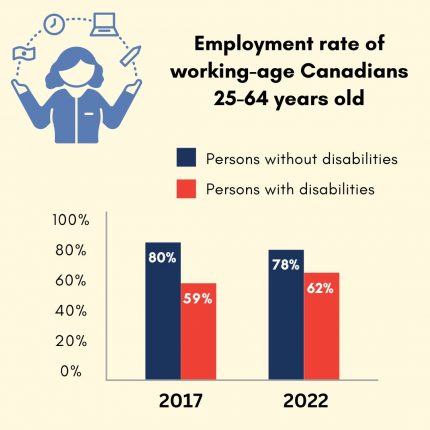Supported Employment
A Bridge between Job Seekers and Employers
Pour la version française de cet article, veuillez cliquer ici. | For the French version of this post, please click here.
Based on the 2022 Canadian Survey on Disability, 27% of Canadians aged 15 years and older, or 8 million people, have one or more disabilities (1). Of the almost 24 million Canadians who are of working age (15-64 years old), nearly one-quarter (24%) or almost 6 million experience disability (2).
Significant Gap in Employment Rates
Persons who experience disability have consistently been employed at lower rates than persons without disability.
The good news is that the 2022 employment rate for persons with disabilities (62%) was up from 2017 (59%), which decreased the gap between persons with and without disabilities (3,4). However, that gap remains significant.
When reviewing statistics about the employment rate of persons experiencing disability, additional factors must be considered. For instance, persons experiencing disability have lower mean hourly wages and annual earnings, and higher rates of involuntary part-time work (5).

Barriers to Labour Market Participation
When we examine why the labour market participation of persons experiencing disability is consistently lower, some common barriers show up.
Some employment barriers faced by job seekers and workers include:
- Recruiting processes that are not accessible
- Unconscious bias and discrimination towards persons experiencing disability and who have intersecting identities
- Unmet workplace accommodations
Some HR and inclusion challenges faced by employers include:
- Knowledge of disability, accessibility, and inclusion
- Fewer employees and existing staff working more hours – hence less capacity to focus on building inclusive workplaces
- Difficulty attracting diverse talent
- Low retention rate
Supported Employment: Bridge between Job Seekers and Employers
Supported employment is one tool that can help both job seekers and employers, because it’s a bridge between the two.
Supported employment starts with the belief that everyone who wants paid employment has the right to participate in the workforce and to contribute economically and socially in a purposeful way.
This successful and accepted model recognizes and supports the unique skills, knowledge, goals, and challenges of job seekers and the needs of employers. Service providers facilitate relevant matches between job seekers and employers and offer customized, person-centred support to ease the transition.
Persons with any type of disability can access supported employment:
- physical, developmental, or intellectual disability
- neurodivergent (example: ADHD, autism)
- mental health challenges (example: depression, anxiety)
- addiction disorders
Intersecting identities can also impact a person’s experience navigating employment:
- racialized groups (example: Black Canadians)
- Indigenous Peoples
- 2SLGBTQIA+
- persons with incomes below poverty level
- seniors
Supported Employment Services
Many supported employment services are offered at no cost to employers and job seekers.
Job seekers and workers can access the following to find a job or succeed in their work:
- Education or training (example: soft skills, digital literacy, job hunting)
- Accommodations (example: tailored interview process, ability to see person’s face to lip read, flexible schedule based on paratransit, etc.)
- Job coaching to assist during recruitment/onboarding
- Mentorship opportunities and facilitation
Employers may need the following to succeed in building an inclusive workplace:
- Access to skilled talent pool to meet labour needs
- Support developing inclusive interview process
- Help integrating new employees experiencing disability
- Training and resources on workplace disability inclusion
Supported employment asks:
How can we help you reach your employment goals?

Photo Credit: Disability:IN
Job Coaching
Job coaching is offered by some supported employment agencies. A job coach provides tailored 1:1 support for a job seeker/employee based on that person’s challenges and goals.
For example, a job coach might:
- Attend an interview to support a job seeker.
- Work with an employer and employee on a step-by-step checklist for a task.
Canadian Association for Supported Employment
Click here for a pdf document that describes CASE and our offerings.
5. Employment and Social Development Canada. Press Release. Released December 7, 2022. Accessed April 12, 2024.

